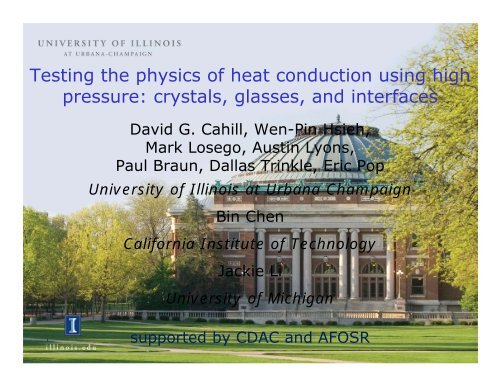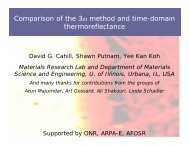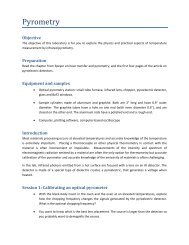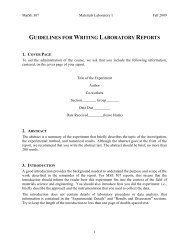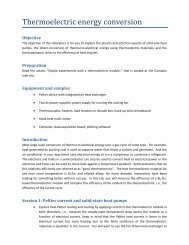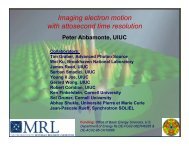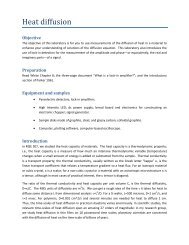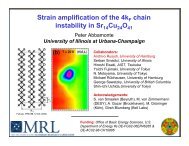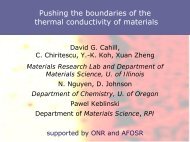Testing the physics of heat conduction using high pressure: crystals ...
Testing the physics of heat conduction using high pressure: crystals ...
Testing the physics of heat conduction using high pressure: crystals ...
Create successful ePaper yourself
Turn your PDF publications into a flip-book with our unique Google optimized e-Paper software.
Thermal conductivity and interface <strong>the</strong>rmal conductance• Thermal conductivity is a property <strong>of</strong> <strong>the</strong>continuum• Thermal conductance (per unit area) G is aproperty <strong>of</strong> an interface
Analyze ratio V in /V out <strong>using</strong> an exactsolution <strong>of</strong> <strong>the</strong> <strong>heat</strong> diffusion equation
Maximum <strong>pressure</strong> achieved in <strong>the</strong>rmalconductivity measurements1 atm=bar1 bar=100 kPa1 Mbar=100 GPaDalton and Hsieh
I. Works well for homogeneous disorderedmaterials but is this model valid for glassypolymers?amorphousdisordered crystalfeldsparPMMA
Test <strong>the</strong> applicability <strong>of</strong> <strong>the</strong> model for glassypolymers• Polymers combine strongcovalent bonds along <strong>the</strong>backbone (and within <strong>the</strong>side groups) and weak“non-bonded” interactionsbetween chains.• At <strong>high</strong> <strong>pressure</strong>s, thisstrong inhomogeneity inbond strength is reduced.C 11 data for PMMA frompicosecond interferometry
Need thin (
Nanoscale polymer brushes “graftedfrom” <strong>the</strong> SiC anvil
Thermal conductivity <strong>of</strong> PMMA polymer isindependent <strong>of</strong> thickness and agrees well with<strong>the</strong> predicted scaling with (C 11 ) 1/2Thermal Conductivity (W m -1 K -1 )10.50.20.1Andersson et al. 0 n 1/6 C 111/210 nm22 nm9 nm6 nm13 nm0 2 4 6 8 10 12Pressure (GPa)
II. Do optical phonons contribute to <strong>heat</strong><strong>conduction</strong> or scatter acoustic phonons?• Leibfried-Schlömann equation– acoustic phonons dominant <strong>heat</strong>carriers– three phonon anharmonic scatteringbetween acoustic modes controlsphonon mean-free-pathfV1/33D2TV molecular volume = Debye frequency Gruneisen parameter• Test <strong>using</strong> relative low modulus water ice thatis compressed by 33% at P=22 GPa.
Water ice has a remarkably rich phase diagramPetrenko and Whitworth (1999)
Ice VII, cubic with two interpenetrating but notinterconnected bcc sub-lattices• Hydrogen-bonding inice VII is disordered• Ice VIII is <strong>the</strong> protonordered form• Ice X is thought to be“polymeric”: H-bondis symmetricC.J. Knight, Ph.D. <strong>the</strong>sis (2009)
Use Al-coated mica as a substrate. Measure <strong>using</strong>Ar and <strong>the</strong>n with ice.Diamond anvil cell
Measuring <strong>the</strong>rmal conductivity <strong>of</strong> water ice VII• Experimental details are complicated1. coat thin mica substrate with Al2. measure mica with Ar <strong>pressure</strong> medium3. use published MD simulation <strong>of</strong> Ar <strong>the</strong>rmalconductivity to analyze <strong>the</strong> data for mica4. measure again with H 2 O ice as <strong>the</strong><strong>pressure</strong> medium5. use density functional <strong>the</strong>ory to calculatechanges in H 2 O <strong>heat</strong> capacity per unitvolume6. analyze <strong>the</strong> data7. repeat...
Derive changes in Debye frequency ω D andGrüneisen parameter γ from equation <strong>of</strong> state V(P)• Data for V(P) are fitto a model (e.g.,Birch-Murnaghan)• Assume ω D scaleswith K 1/2• γ is derived from asecond derivative <strong>of</strong><strong>the</strong> V(P) curve.V(P) <strong>of</strong> ice VII by synchrotronx-ray diffractionFrank et al., Geochimica et Cosmochimica Acta, 2004
Good agreement with LS equation overwide range <strong>of</strong> compression
III. What is <strong>the</strong> role <strong>of</strong> weak interfacialbonding in <strong>the</strong>rmal transport at interfaces?• Elastic constants andphonon spectra <strong>of</strong>typical materials do notchange much between0
Interface stiffness s is analogous tointerface <strong>the</strong>rmal conductance Gapply <strong>pressure</strong>, Papply <strong>heat</strong> flux, Jdisplacement, dd1sP ( )PTemperature, TT1GJzz
Deposit Al on SiC with and without coating withmonolayer CVD graphene by transfer-printingDiamond anvil cell
Clean SiC anvil at <strong>high</strong> temperaturesand deposit Al film in-situ by sputtering
Compare clean interface with a layer <strong>of</strong>CVD graphene inserted at <strong>the</strong> interface• Clean interface has <strong>the</strong>weak <strong>pressure</strong>dependence expectedfrom diffuse-mismatch(DMM) calculations.• Insert graphene: lowconductance andstrong <strong>pressure</strong>dependence.• At P>8 GPa, “weak”interface becomes“strong” andconductance is <strong>high</strong>.
Summary• Pressure dependence <strong>of</strong> PMMA polymer in good agreementwith <strong>the</strong> model <strong>of</strong> <strong>the</strong> minimum <strong>the</strong>rmal conductivity– Polymers do not resemble <strong>the</strong> atomic solids <strong>the</strong> model wasoriginally intended for. Why is this model is so robust?• Pressure dependence <strong>of</strong> ice VII in good agreement withLeibfried-Schlömann equation– Optical phonons are not an important factor for <strong>the</strong>rmalconductivity <strong>of</strong> water ice ei<strong>the</strong>r as carriers or scatteringmechanisms. Will this be true for oxide minerals?• Pressure dependence <strong>of</strong> typical (dirty, weakly bonded)interfaces is in poor agreement with <strong>the</strong> diffuse mismatchmodel– Weak interfacial bonding suppresses <strong>heat</strong> <strong>conduction</strong> atinterfaces. Pressure can be used to vary <strong>the</strong> strength <strong>of</strong>interface bonding.


